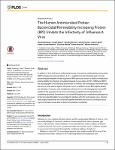The Human Antimicrobial Protein Bactericidal/Permeability-Increasing Protein (BPI) Inhibits the Infectivity of Influenza A Virus
Pinkenburg, Olaf
Meyer, Torben
Bannert, Norbert
Norley, Steven
Bolte, Kathrin
Czudai-Matwich, Volker
Herold, Susanne
Gessner, André
Schnare, Markus
In addition to their well-known antibacterial activity some antimicrobial peptides and proteins (AMPs) display also antiviral effects. A 27 aa peptide from the N-terminal part of human bactericidal/permeability-increasing protein (BPI) previously shown to harbour antibacterial activity inhibits the infectivity of multiple Influenza A virus strains (H1N1, H3N2 and H5N1) the causing agent of the Influenza pneumonia. In contrast, the homologous murine BPI-peptide did not show activity against Influenza A virus. In addition human BPI-peptide inhibits the activation of immune cells mediated by Influenza A virus. By changing the human BPIpeptide to the sequence of the mouse homologous peptide the antiviral activity was completely abolished. Furthermore, the human BPI-peptide also inhibited the pathogenicity of the Vesicular Stomatitis Virus but failed to interfere with HIV and measles virus. Electron microscopy indicate that the human BPI-peptide interferes with the virus envelope and at high concentrations was able to destroy the particles completely.
Files in this item
No license information

